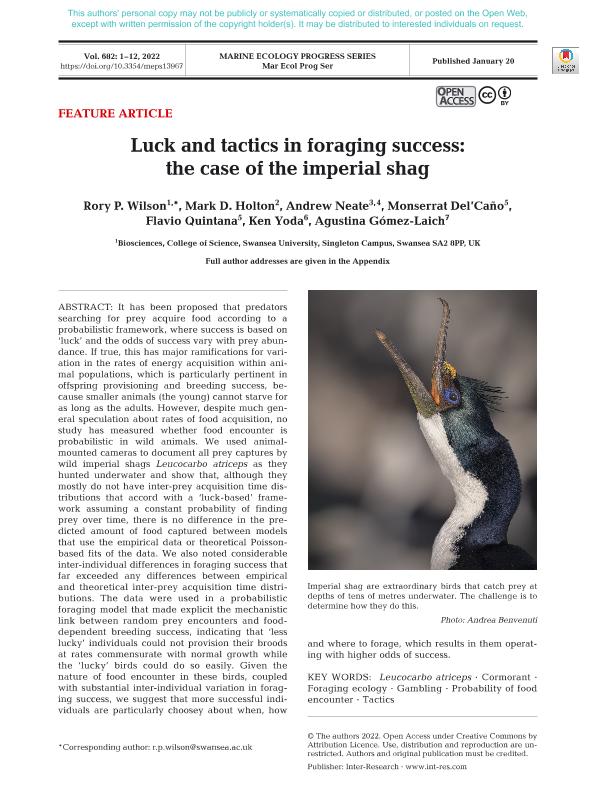Mostrar el registro sencillo del ítem
dc.contributor.author
Wilson, Rory P

dc.contributor.author
Holton, Mark

dc.contributor.author
Neate, Andrew
dc.contributor.author
del Caño, María Monserrat

dc.contributor.author
Quintana, Flavio Roberto

dc.contributor.author
Yoda, Ken
dc.contributor.author
Gómez Laich, Agustina Marta

dc.date.available
2023-07-17T12:26:45Z
dc.date.issued
2022-01-20
dc.identifier.citation
Wilson, Rory P; Holton, Mark; Neate, Andrew; del Caño, María Monserrat; Quintana, Flavio Roberto; et al.; Luck and tactics in foraging success: the case of the imperial shag; Inter-Research; Marine Ecology Progress Series; 682; 20-1-2022; 1-12
dc.identifier.issn
0171-8630
dc.identifier.uri
http://hdl.handle.net/11336/204088
dc.description.abstract
It has been proposed that predators searching for prey acquire food according to a probabilistic framework, where success is based on 'luck' and the odds of success vary with prey abundance. If true, this has major ramifications for variation in the rates of energy acquisition within animal populations, which is particularly pertinent in offspring provisioning and breeding success, be - cause smaller animals (the young) cannot starve for as long as the adults. However, despite much general speculation about rates of food acquisition, no study has measured whether food encounter is probabilistic in wild animals. We used animalmounted cameras to document all prey captures by wild imperial shags Leucocarbo atriceps as they hunted underwater and show that, although they mostly do not have inter-prey acquisition time distributions that accord with a 'luck-based' framework assuming a constant probability of finding prey over time, there is no difference in the predicted amount of food captured between models that use the empirical data or theoretical Poissonbased fits of the data. We also noted considerable inter-individual differences in foraging success that far exceeded any differences between empirical and theoretical inter-prey acquisition time distributions. The data were used in a probabilistic for aging model that made explicit the mechanistic link between random prey encounters and fooddependent breeding success, indicating that 'less lucky' individuals could not provision their broods at rates commensurate with normal growth while the 'lucky' birds could do so easily. Given the nature of food encounter in these birds, coupled with substantial inter-individual variation in foraging success, we suggest that more successful individuals are particularly choosey about when, how and where to forage, which results in them operating with higher odds of success.
dc.format
application/pdf
dc.language.iso
eng
dc.publisher
Inter-Research

dc.rights
info:eu-repo/semantics/openAccess
dc.rights.uri
https://creativecommons.org/licenses/by/2.5/ar/
dc.subject
LEUCOCARBO ATRICEPS
dc.subject
CORMORANT
dc.subject
FORAGING ECOLOGY
dc.subject
GAMBLING
dc.subject
PROBABILITY OF FOOD ENCOUNTER
dc.subject
TACTICS
dc.subject.classification
Zoología, Ornitología, Entomología, Etología

dc.subject.classification
Ciencias Biológicas

dc.subject.classification
CIENCIAS NATURALES Y EXACTAS

dc.title
Luck and tactics in foraging success: the case of the imperial shag
dc.type
info:eu-repo/semantics/article
dc.type
info:ar-repo/semantics/artículo
dc.type
info:eu-repo/semantics/publishedVersion
dc.date.updated
2023-07-06T11:03:57Z
dc.identifier.eissn
1616-1599
dc.journal.volume
682
dc.journal.pagination
1-12
dc.journal.pais
Alemania

dc.journal.ciudad
Oldendorf/Luhe
dc.conicet.avisoEditorial
The authors 2022. Open Access under Creative Commons by Attribution Licence. Use, distribution and reproduction are un restricted. Authors and original publication must be credited. Publisher: Inter-Research · www.int-res.com
CC BY
dc.description.fil
Fil: Wilson, Rory P. Swansea University. College of Sciences; Reino Unido. Swansea University; Reino Unido
dc.description.fil
Fil: Holton, Mark. Swansea University. College of Sciences; Reino Unido
dc.description.fil
Fil: Neate, Andrew. Swansea University. College of Sciences; Reino Unido
dc.description.fil
Fil: del Caño, María Monserrat. Consejo Nacional de Investigaciones Científicas y Técnicas. Centro Científico Tecnológico Conicet - Centro Nacional Patagónico. Instituto de Biología de Organismos Marinos; Argentina
dc.description.fil
Fil: Quintana, Flavio Roberto. Consejo Nacional de Investigaciones Científicas y Técnicas. Centro Científico Tecnológico Conicet - Centro Nacional Patagónico. Instituto de Biología de Organismos Marinos; Argentina
dc.description.fil
Fil: Yoda, Ken. Nagoya University; Japón
dc.description.fil
Fil: Gómez Laich, Agustina Marta. Consejo Nacional de Investigaciones Científicas y Técnicas. Oficina de Coordinación Administrativa Ciudad Universitaria. Instituto de Ecología, Genética y Evolución de Buenos Aires. Universidad de Buenos Aires. Facultad de Ciencias Exactas y Naturales. Instituto de Ecología, Genética y Evolución de Buenos Aires; Argentina
dc.journal.title
Marine Ecology Progress Series

dc.relation.alternativeid
info:eu-repo/semantics/altIdentifier/doi/http://dx.doi.org/10.3354/meps13967
dc.relation.alternativeid
info:eu-repo/semantics/altIdentifier/url/https://www.int-res.com/abstracts/meps/v682/p1-12/
Archivos asociados
